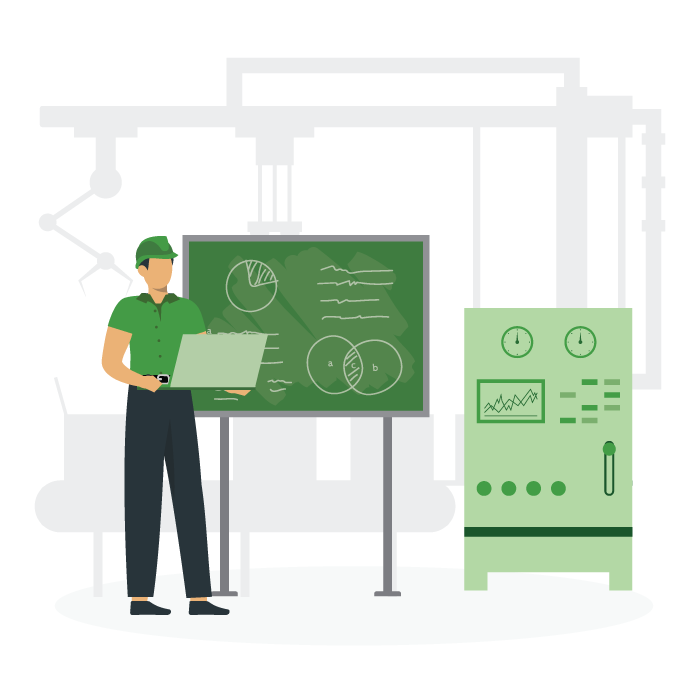Maintenance Management
Everything you ever needed to know about maintenance management
What is maintenance management?
Maintenance management encompasses all of the processes involved in preserving a company’s physical assets. Its main goal is to improve asset availability and reliability to maximize the efficacy of the company’s core services. As such, it is a foundation for industrial maintenance and facilities management.
From a practice that began as the sole preserve of the industrial sector, maintenance management has evolved significantly over the years. It has progressed from a tedious, often error-ridden exercise into a more precise, technology-backed system with the following objectives:
- Planning maintenance work. Through effective planning, organizations can efficiently distribute their time, labor, tools, and other maintenance resources to focus on proactive work and be able to quickly deal with arising asset issues.
- Minimizing equipment failures and production downtime. Well-managed asset maintenance helps to maximize equipment availability and performance. Even when downtime occurs, it is infrequent, and it is corrected quickly and efficiently.
- Controlling maintenance costs. MRO (maintenance, repair, operations) activities can be a major part of the company’s operational expenses. Most maintenance teams have to constantly perform a balancing act – trying to deliver quality maintenance work within a very limited maintenance budget.
- Ensuring regulatory compliance. Every industry has its set of regulations that could attract severe fines and penalties if flouted. And as far as regulatory agencies are concerned, if there’s no traceable record, it didn’t happen. Modern maintenance management comes with tools like CMMS that make it easier to automate and record inspections, conduct internal audits, and create the necessary reports.
- Ensuring personnel and equipment safety. By nature, many fixtures and equipment are hazardous when they malfunction (e.g. boilers, compressors, electrical installations, etc). Through proactive maintenance and safety training, maintenance management creates a safe and productive work environment.
Guide to Moving from Reactive to Preventive Maintenance
Want to transition away from costly reactive maintenance but don't know where to start? This guide has everything you need to know.
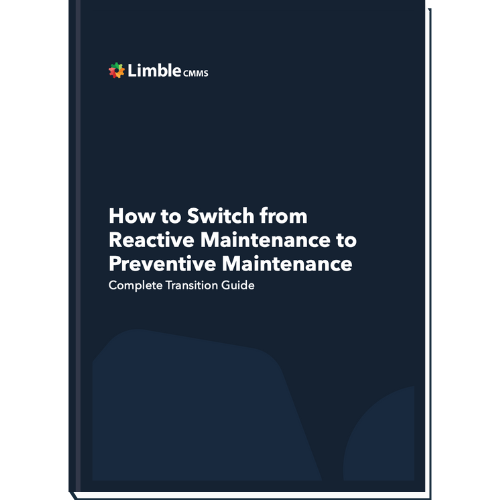
Consequences of poor maintenance practices
Maintenance is so interconnected and ingrained with business operations that any inefficiencies will eventually have a ripple effect throughout the organization.
In the picture below, we see some implications of poor/disorganized maintenance that are immediately obvious (increased labor, contracts, and materials costs). In comparison, there is so much more that is hidden and creeps up later (in the form of safety risks, lost production hours, higher energy costs, etc).
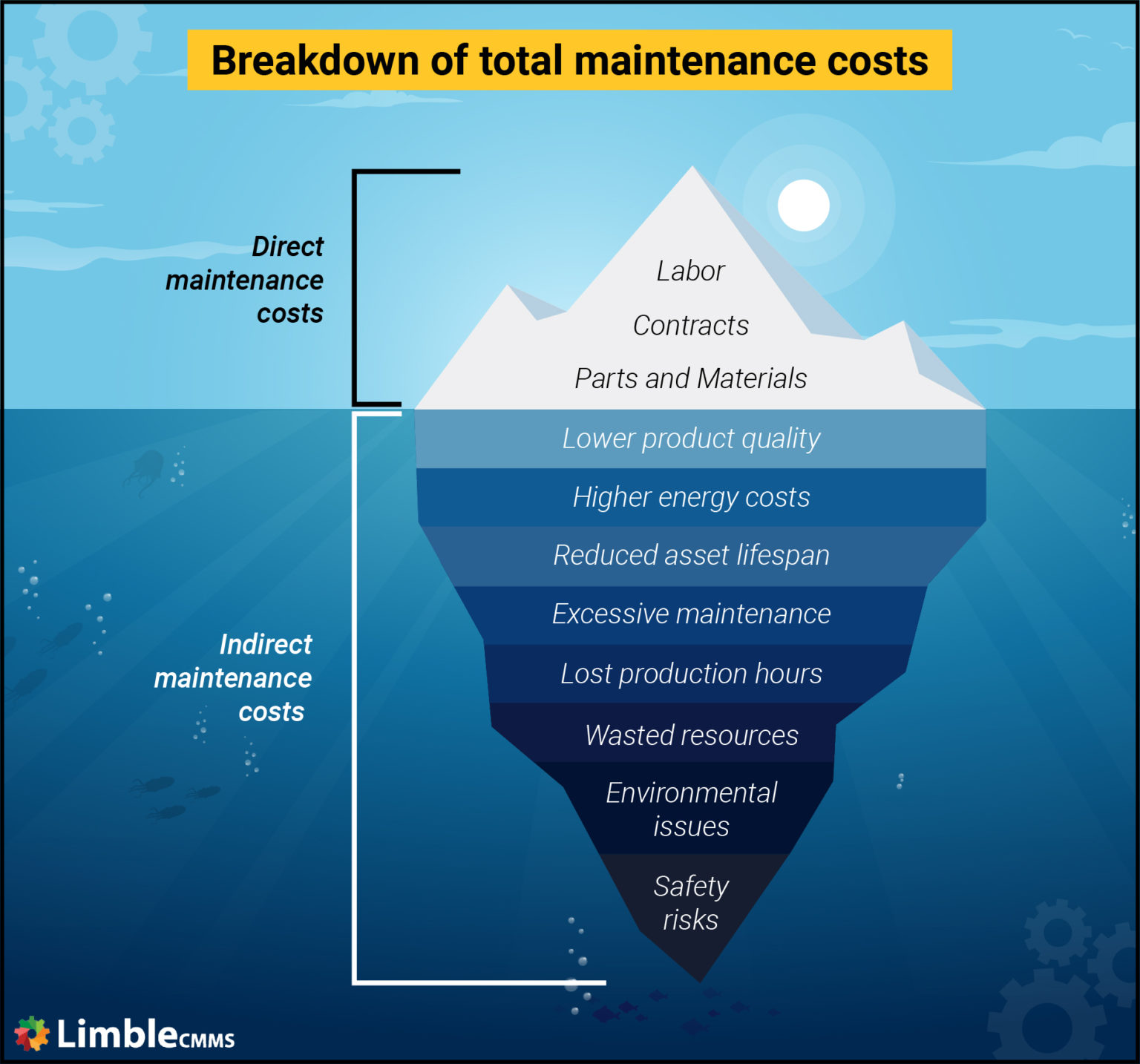
All of those indirect maintenance costs can be eliminated, or at least minimized, through proper maintenance management.
The scope of maintenance management
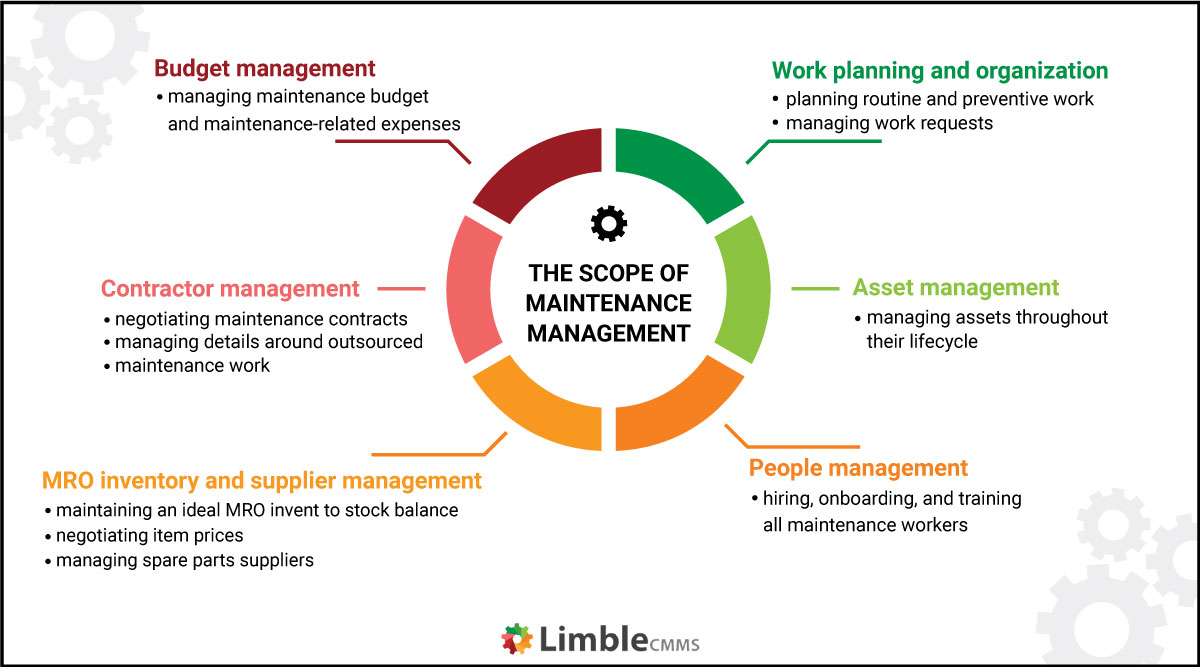
In this chapter, we’ll outline some of the major elements that make up the framework for maintenance management, as well as typical activities they include.
Work planning and management
Maintenance management needs to allocate the needed resources and tools for organizing and planning preventive maintenance work, as well as for dealing with maintenance emergencies.
Typical activities include:
- Managing incoming work requests
- Work order management
- Planning routine and preventive maintenance work
Asset management
Asset management is at the core of maintenance management. It is a strategic and analytical approach to the management of a company’s assets throughout its three distinct life cycle stages:
- Procurement/acquisition: identifying the need for a particular item, planning, purchasing, and commissioning it.
- Operation/maintenance: this period marks the useful life of the asset. The asset is used to generate value and needs to be routinely looked after to avoid breakdowns which can reduce its lifespan. This is the longest asset lifecycle and usually includes a variety of maintenance and repair work.
- Disposal: maintenance costs gradually build up till it becomes uneconomical to keep the asset running.
Although every asset that a business owns matters, some equipment will be more important than others. The importance is determined by several factors such as how costly the asset is to replace and how critical it is to achieve organizational goals.
People management
Ultimately, it falls to your maintenance staff to execute everything and keep the operations running smoothly. Therefore, it’s safe to say that your maintenance programs are only as good as the people implementing them.
Typical activities for managing the maintenance workforce include:
- Hiring and onboarding new maintenance workers
- Establishing clear responsibilities and organizational hierarchy
- Creating the required procedures and safety guidelines
- Training and upskilling workers as needed
- Keeping the workers accountable, as well as motivated
MRO inventory and supplier management
MRO inventory refers to the products and tools that a company purchases to keep its operations running. Examples include light bulbs, cleaning supplies, lubrication oil, bolts, nuts, screws, spare replacement parts, and so on.
Because of the negative impacts of over and understocking, companies often struggle with getting the right balance for their MRO inventory. An important part of maintenance management is to ensure an ideal MRO stock balance and avoid work disruptions caused by problems with parts availability.
Because inventory plays a crucial part in maintenance management, MRO suppliers have the potential to impact the success of your maintenance program. This is why many maintenance and facility managers are looking to develop long-term relationships with their suppliers, on top of using digital tools to forecast inventory needs and other spare parts management best practices.
Typical activities include:
- Tracking item usage (inventory control)
- Making inventory forecasts
- Negotiating item prices
- Discuss changes and problems
- Tracking and managing inventory costs for each supplier
Contractor management
Nine out of ten facilities outsource at least one part of their maintenance workload.
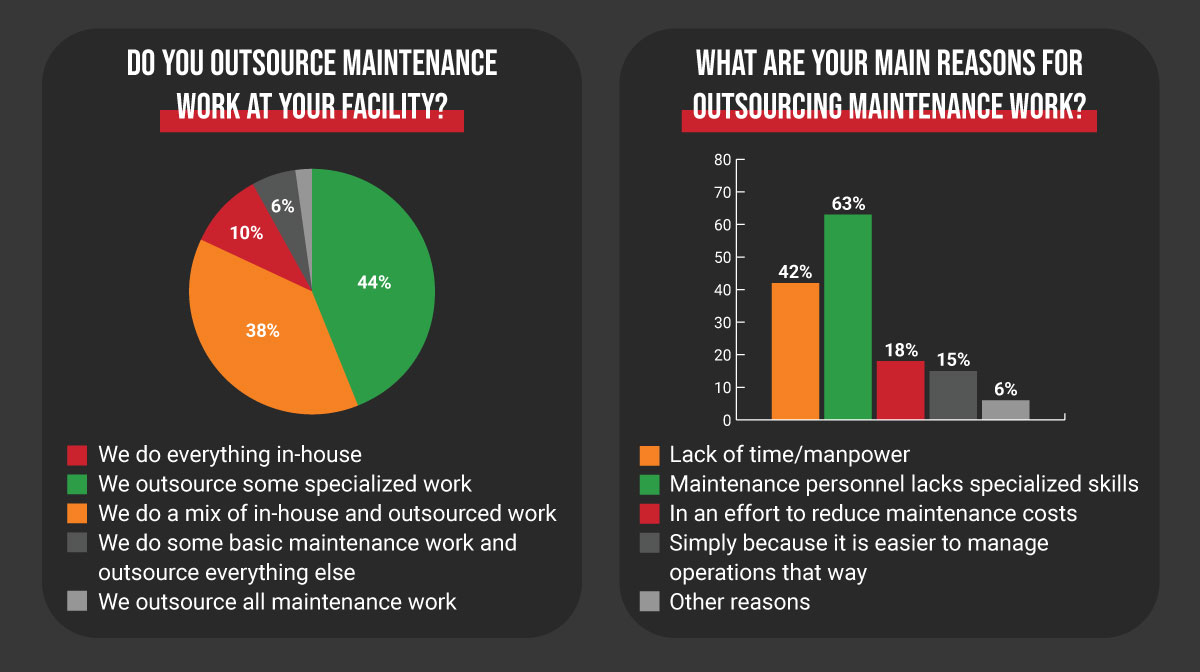
Typical activities that revolve around managing maintenance contractors include:
- Finding contractors for specialized maintenance tasks
- Negotiating maintenance contracts
- Sending out work requests and tracking compliance/performance
- Communicating changes and problems
- Tracking costs associated with each contractor
Budget management
Maintenance work raises the level of equipment performance and availability, but at the same time, it adds to running costs. Ideally, companies should seek an optimum balance between the two.
By gathering, tracking, and analyzing total costs, maintenance managers can gain insights, improve budgeting, and align their activities to be more in tune with the organization’s financial projections.
Typical activities include:
- Managing maintenance budget
- Allocating the budget for specific maintenance activities
- Finding areas to cut costs and create more cost-effective processes
- Creating and generating reports
- Tracking total maintenance costs

Types of maintenance management approaches
Now that we’ve got all that out of the way, you’re probably wondering how to tackle your maintenance management strategy – or how to even start in the first place. Let’s dive right in.
Broadly speaking, there are two major directions to maintenance management, reactive and proactive. More and more organizations are focusing on the latter.
The evolution of maintenance management strategies
Building and equipment maintenance started in the industrial setting from a very straightforward and reactive standpoint – use a piece of equipment until it breaks, then fix it – no routine maintenance in between. Although this practice seemed fast, cheap, and easy on the surface, organizations quickly realized it isn’t sustainable.
As manufacturing operations continued to scale up, reactive maintenance caused additional complications like supply chain and quality control problems. Gradually, the idea of proactive maintenance – regularly inspecting and maintaining important assets – took hold.
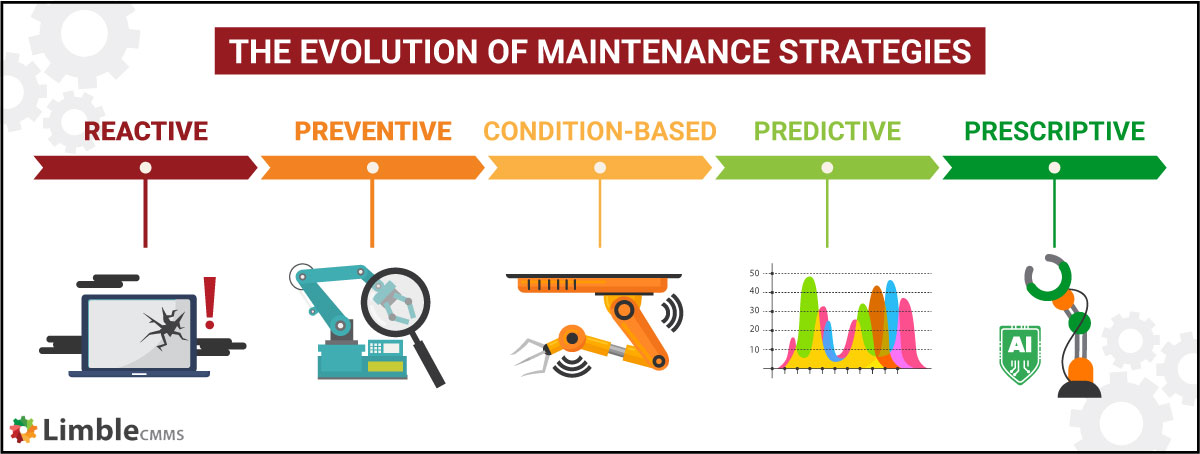
With the introduction of maintenance software, condition monitoring sensors, and IIoT technology, maintenance has continued to evolve. Today, companies can have access to high volumes of maintenance data they can use to predict equipment issues and optimize maintenance workload.
We’ll briefly discuss the most popular proactive maintenance strategies in the next section.
Options for proactive maintenance management
This list of proactive maintenance strategies is set up to go from the cheapest and simplest to implement to more advanced and complex approaches:
- Preventive maintenance (PM) is the most popular proactive maintenance strategy. Maintenance work is performed at regular intervals. The intervals are either calendar-based or usage-based.
- Condition-based maintenance (CBM) is a maintenance methodology where the condition of the asset is monitored through condition monitoring technology. Maintenance work is performed when sensors (or tests performed with handheld equipment) show that the asset is experiencing an issue.
- Predictive maintenance (PdM) uses a combination of condition monitoring sensors and machine learning to forecast when a machine is likely to fail. It works like an early warning system that gives maintenance personnel alerts, notifications, and enough time to plan and schedule repair/servicing before failure occurs.
- Prescriptive maintenance goes one step beyond PdM. With prescriptive maintenance, the machines use sensors and analytics to perform self-diagnosis and present technicians with a few solutions on how to deal with the identified issue(s).
On top of each of those strategies, companies that strive to create a lean organization can implement concepts like autonomous maintenance and total productive maintenance (TPM).
How to select the right maintenance management strategy
Since company culture, industry, and assets differ, so do their maintenance management needs. There is no one-size-fits-all solution for all businesses since every maintenance strategy has its set of pros and cons.
We are the advocates of a “mixed” approach. For example, an organization may use a predictive maintenance program for critical assets, while placing other equipment on a preventive maintenance plan. Or, if you have a very tight budget, you may choose to use a mix of reactive and preventative maintenance. The most important thing is to ensure that each asset gets the amount of attention that is relative to its importance for the organization.
For more insights, check out our side-by-side comparison of reactive vs preventive vs predictive maintenance.
Setting up an efficient maintenance department
We mentioned before that your maintenance program is only as good as your team. However, there are always two sides to a coin. You can have the best talent, but if you can’t provide an enabling environment, you’re going to have a whole host of problems.
There are a few crucial things you want to get right:
- Hire or train a qualified team of maintenance workers
- Focus on building a proactive work culture
- Standardize work through manuals, SOPs, and checklists
- Implement a CMMS or another digital solution to streamline maintenance processes
- Ensure that maintenance teams have the right tools to perform their job
- Work on establishing lean maintenance practices through continuous improvement
- Select and set maintenance KPIs and metrics you want to track
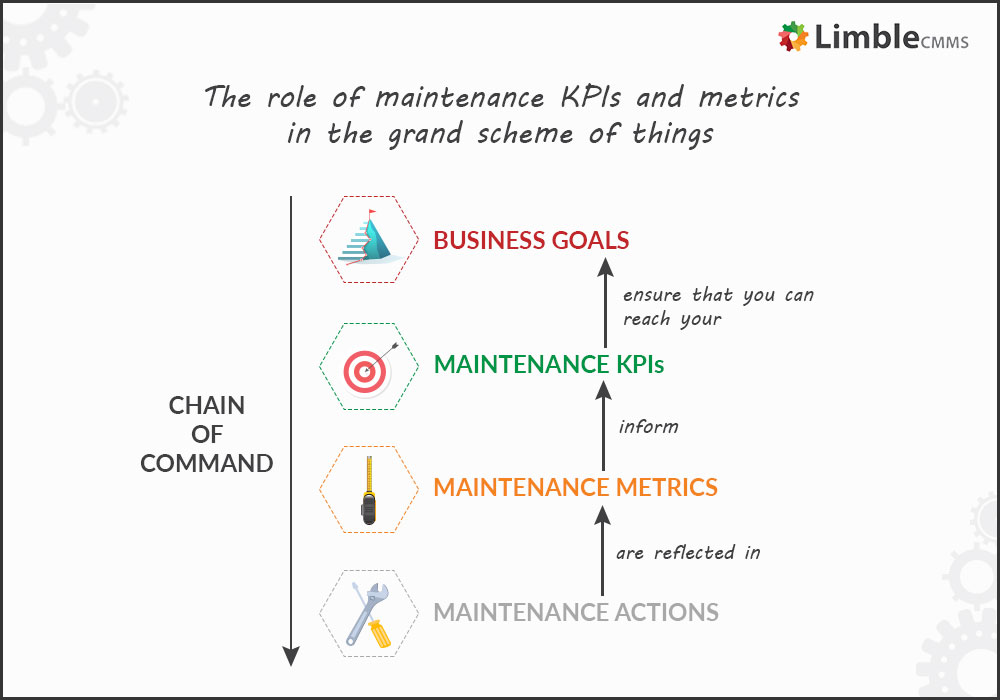
For further information, read our guide on how to set up your maintenance team for success.
In your quest to have an efficient maintenance department, one resource that will prove to be exceptionally beneficial is maintenance management software. We’ll discuss how next.
Streamlining work with maintenance management software
Every industry has its set of technologies and solutions that simplifies and automates work. Accountants have a variety of financial software. The medical industry has its set of solutions for patient monitoring, regulatory compliance, etc. Maintenance and facility managers have CMMS. CMMS is the go-to solution for the optimization of maintenance operations.
Over the years, the computerized maintenance management system has played a pivotal role In the advancement of maintenance management. However, some CMMS software is better than others. A best-in-class CMMS brand will offer its users the following core features:
- Work orders: most CMMS solutions offer some kind of work request portal people can use to quickly submit work requests. More advanced solutions like Limble include algorithms that check for and automatically discard improper and duplicate tickets.
- Work planning and scheduling: the user-friendly interface should allow staff to view and create maintenance calendars and maintenance schedules, automate PM planning, distribute reminders before due dates, change work priority on the fly, and anything else that is needed to organize maintenance workflows.
- Centralized maintenance database: CMMS software effortlessly collates maintenance information and serves as a centralized database for any and all asset information. By clicking on an asset, users can access key information, like its history, reports, issues, expenses, all in one place.
- Spare parts inventory management: spare parts inventory management is not something to be tracked manually. This module allows users to automate most of the MRO inventory management and stay on top of parts usage, inventory forecasting, reorder levels, and associated expenses.
- Vendor management: centralize information for multiple vendors, manage their contracts and contacts, track their performance over time, and track costs associated with each vendor.
- Report generation: receive actionable insights into every aspect of your asset management operations from tracking costs to tracking KPIs. Additionally, these reports can be used as evidence for regulatory compliance audits.
- Mobile CMMS: modern maintenance software needs to be accessible on mobile devices if you want to maximize the performance of your maintenance team.
The Essential Guide to CMMS
Download this helpful guide to everything a CMMS has to offer.

Want to see Limble in action? Get started for free today!
Using Limble CMMS to organize maintenance work
The features we outlined in the previous section are a good representation of what Limble can do for your maintenance department. However, we understand that implementing a CMMS can be a big decision. You want to make sure you select maintenance software that is a good fit for your organization.
Naturally, most organizations want to first test the software. It is very important to check how easy all of those features are to use. For all of you who’d be interested in taking Limble CMMS out for a spin, we have three options:
Before you go
Investing in maintenance management is not a sexy proposal. Probably because it can take a while to start seeing a significant return on that investment. Sometimes, it might seem like top management can’t grasp the concept of the long-term outlook. This is somewhat ironic because that is literally their job – to think years ahead, not months.
Be that as it may, maintenance and facility managers have to continuously push them to stop thinking about maintenance as a cost center and start seeing it for what it truly is – a value-adding activity that increases the performance of the whole organization.

